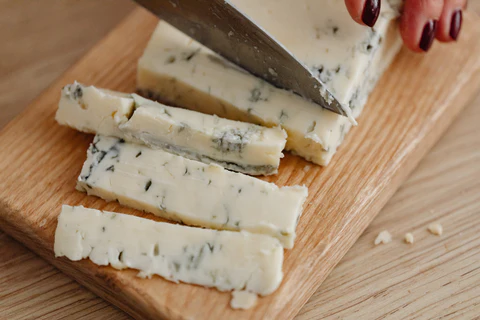Cheese lovers around the world are always on the lookout for something unique, flavorful, and visually appealing. Among the many varieties available, Masgonzola stands out as a true masterpiece in dairy craftsmanship. This luxurious marbled cheese, made by combining silky-smooth mascarpone with the assertive character of blue cheese, offers a taste experience like no other. It’s not just a cheese—it’s a balance of two worlds: mild creaminess and bold intensity.
In this article, we’ll explore the origins of Masgonzola, its flavor profile, production process, pairing ideas, and the many ways it can be enjoyed in both sweet and savory dishes.
1. What is Masgonzola?
At its core, Masgonzola is a fusion cheese—a marriage of two very different yet complementary personalities in the dairy world.
- Mascarpone: Known for its smooth, buttery texture and subtle sweetness, mascarpone is an Italian cream cheese traditionally used in desserts like tiramisu.
- Blue Cheese: Recognized for its bold aroma and sharp, tangy taste, blue cheese is streaked with blue-green veins created by mold cultures such as Penicillium roqueforti.
When combined, these two create something magical. The mascarpone tones down the strong bite of blue cheese, while the blue cheese adds depth and complexity to the mascarpone. The result? A perfectly balanced cheese that appeals to both adventurous eaters and those who prefer a gentler flavor.
2. The Origins of Masgonzola
The name Masgonzola is derived from its two main components: “Mas” from mascarpone and “Gonzola” from gorgonzola, one of Italy’s most famous blue cheeses. Though its exact origins are not firmly documented, the concept is rooted in Italy’s long tradition of blending dairy products to create unique textures and flavors.
This cheese is relatively modern compared to centuries-old cheeses like Parmigiano-Reggiano or Roquefort. Artisanal cheesemakers began experimenting with mascarpone and blue cheese blends in the late 20th century to offer a more approachable option for consumers who were curious about blue cheeses but found them too intense.
3. Appearance and Texture
Masgonzola is visually striking. Its creamy ivory body is laced with dramatic deep-blue veins, creating an artistic marbling effect that makes it stand out on any cheese board.
In terms of texture:
- Soft and spreadable when at room temperature, perfect for smearing onto fresh bread or crackers.
- Creamy and dense, but not crumbly like traditional blue cheese.
- Melts beautifully, making it ideal for sauces and baked dishes.
4. Flavor Profile
The flavor of Masgonzola is best described as rich, buttery, and tangy with a mild earthiness. It begins with the smooth sweetness of mascarpone, followed by the subtle tang and saltiness of blue cheese. Unlike more aggressive blues, the sharpness here is balanced, making it suitable even for people who typically shy away from stronger cheeses.
- Initial taste: Creamy, milky sweetness.
- Mid-palate: Gentle tang from the blue cheese cultures.
- Finish: A lingering savory depth without bitterness.
5. How Masgonzola is Made
While variations exist depending on the cheesemaker, the general production process involves:
- Making Mascarpone
Fresh cream is cultured with a mild acid (such as lemon juice or tartaric acid) to thicken and form mascarpone. - Preparing the Blue Cheese
A selected blue cheese variety—often gorgonzola—is aged until it develops the desired flavor intensity. - Blending the Two
The mascarpone and blue cheese are carefully combined, ensuring the marbling effect is preserved. The mixture may be lightly molded to hold shape. - Maturation
Some versions are eaten fresh, while others are allowed to age for a short period to deepen the flavors.
6. Nutritional Profile
Like most cheeses, Masgonzola is a rich source of calcium, protein, and healthy fats. However, it’s also indulgent, so portion control is key.
A typical serving (1 oz / 28g) contains:
- Calories: ~100–120
- Protein: 2–3g
- Fat: 10–11g
- Calcium: ~10% of daily recommended intake
It also provides small amounts of vitamins A and B12, which are important for vision, immunity, and nerve health.
7. Culinary Uses of Masgonzola
Masgonzola’s versatility is one of its strongest points. It works equally well in sweet and savory recipes, as well as in simple snack pairings.
Savory Ideas:
- Pasta Sauce: Melt Masgonzola into cream for a decadent pasta sauce with subtle tang.
- Gourmet Pizza: Add dollops on top of a prosciutto and arugula pizza for extra richness.
- Stuffed Chicken: Fill chicken breasts with Masgonzola and spinach for a flavorful main course.
- Salad Topping: Crumble over roasted beet and walnut salads for color and taste.
Sweet Ideas:
- Cheesecake: Incorporate Masgonzola into a cheesecake for a surprising twist.
- Fruit Pairing: Serve with fresh figs, pears, or grapes to balance sweetness with savory depth.
- Honey Drizzle: Spread on warm bread and drizzle with honey for a luxurious treat.
8. Pairing Masgonzola with Drinks
A good cheese deserves a good drink to enhance its flavors.
- Wine: Pairs beautifully with dessert wines like Sauternes or Port, as well as light reds like Pinot Noir.
- Beer: Belgian tripels or wheat beers complement its creaminess.
- Non-alcoholic: Sparkling water with a squeeze of lemon cuts through the richness.
9. Storage Tips
To keep Masgonzola fresh:
- Store in wax paper or cheese paper inside an airtight container in the refrigerator.
- Avoid plastic wrap directly on the cheese, as it can trap moisture and affect texture.
- Consume within 1–2 weeks for best flavor.
10. Why Masgonzola is Loved Worldwide
The charm of Masgonzola lies in its ability to please different palates. For fans of bold flavors, it offers the complexity of blue cheese. For those who prefer mild tastes, it tempers that strength with mascarpone’s creaminess. It is as much a feast for the eyes as it is for the taste buds, making it a centerpiece at gatherings.
Final Thoughts
Masgonzola is more than just another cheese—it’s a culinary bridge between bold and mild, sweet and savory, tradition and innovation. Whether you’re enjoying it simply spread on fresh bread or incorporating it into elaborate recipes, its unique balance will keep you coming back for more.
If you haven’t tried Masgonzola yet, add it to your next cheese board. You might just discover your new favorite indulgence.



